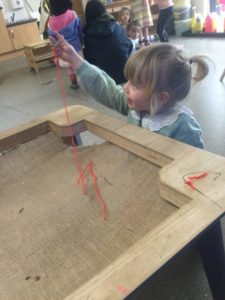Our children love to sew, learning through real first hand experiences.

“I would like to make a purse, first I need to measure it out and draw straight lines”
“Now I’m cutting out my pattern, I love this material because I like to eat apples”
”I can easily thread the needle “
”the sewing is a bit tricky for me”
“I’m sewing buttons on, two I think that will help to close my purse”

”My purse looks great, I think I will sew some ribbon onto it to make it extra special”
”I’m sewing a bag to put my things in” “I chose this nice material because I like it the best”
“Im choosing blue ribbon for my bag so I can carry it” 
“I’m putting the wool through the needle”
Some of our younger children enjoy practicing their sewing on the hessian table.
”up and down up and down “
Well done girls can’t wait to see what other ideas you will have for our sewing area.





















































